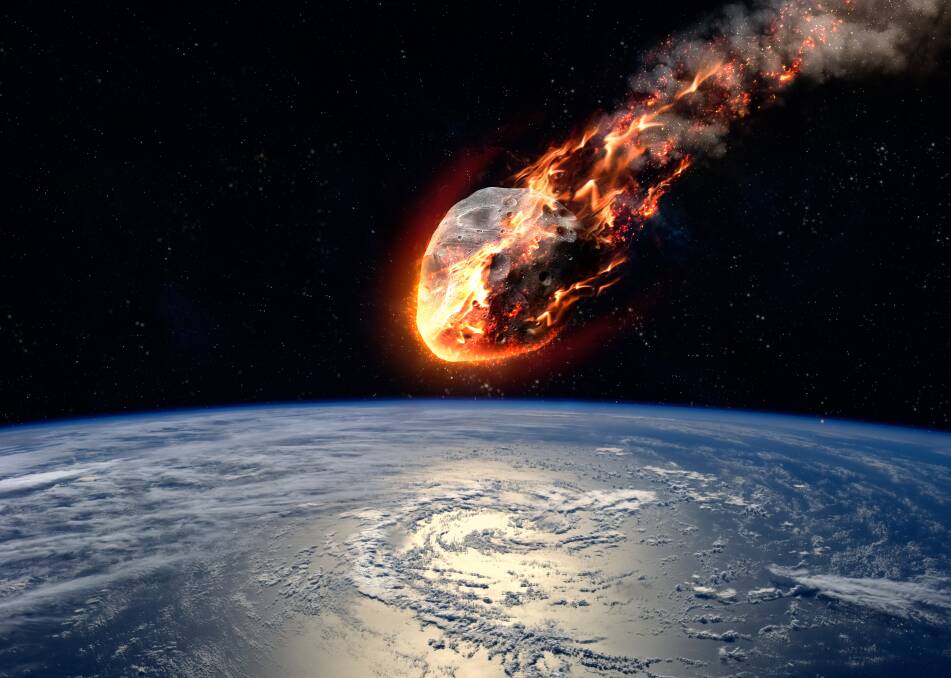A meteor glowing as it enters the Earth’s atmosphere. Elements of this image furnished by NASA. Picture: Shutterstock
Asteroid 2018VP1 is headed for the Earth, at about 85,000 km/hr and may hit the day before the US election. Yes, it is true and you may have already heard this. Last week, asteroid 2020 QG, zoomed past the Earth, becoming the closest known asteroid to hit the Earth. But should we worry about these? Or asteroids hitting the Earth ala Armageddon or Deep Impact? Well, not these … but we do need to look for them.

Currently, we know of 986,954 asteroids in our Solar System (according to the International Astronomical Union Minor Planet Catalog, which keeps official tabs on these things).
However, millions of them likely exist. Most of these reside in the asteroid belt, the area between Mars and Jupiter. Occasionally, they bump into each other and bits break off, travelling through space and sometimes colliding with planets and moons.
When hitting the Earth, or any object for that matter, size does matter. Most of the meteors (shooting stars) you see at night are tiny – the size of a grain of sand, or a small pebble.
They are not very big. Even the big, bright ones are tens of centimetres big. Every day, hundreds of tons of debris – mostly bits of asteroids – hit the Earth’s atmosphere and burn up without harm.
They also hit the Moon, leaving craters of various sizes. Some are hundreds of kilometres wide, like Vesta at 530km – nearly twice the size of Tasmania. Some, like 2018VP1 are only 2 metres wide.
There are other types of asteroids though. Trojan asteroids for instance are asteroids that share in the same orbits of a planet but never collide with them – preceding and following the planet. Jupiter has a lot of these. Apollo asteroids have a slightly egg-shape orbit and cross the path of the Earth. These aren’t as big as some of the biggest asteroids in the asteroid belt, but because they cross the orbit of the Earth, they are often classified as potentially hazardous – they have the potential to cause significant damage.
In February 2013, an Apollo asteroid, estimated to be about 20 metres wide, hit the Earth over Chelyabinsk, Russia, at a speed of more than 60,000 km/hr. It exploded with about 20 to 30 times the energy of the Hiroshima bomb, injuring 1500 people and damaging thousands of buildings.
In June 1908, also over Russia in Tunguska, an object estimated to be about 100 metres wide exploded as it hit the Earth’s atmosphere, levelling the surrounding forest. Around 66 million years ago, an asteroid (or potentially a comet) between 10 and 80 kilometers wide hit the Earth, eventually leading to a mass-extinction event, and famously, the end of the dinosaurs.
So yes, these objects can do damage, but size does matter. The bigger the rock, the bigger the impact. 2018VP1 is 2 metres wide – 10 times smaller than the one that hit over Chelyabinsk in 2013, 50 times smaller than the one over Tunguska in 1908, and 10,000 times smaller than the one that hit the Earth 66 million years ago.
So if 2018VP1 hits? Ya, it will explode, and if you are directly under the explosion you may feel the shock wave. But most likely, if it does, it will put on a big light show and not much else. And it still only has a about 1 in 200 chance of hitting.
I wouldn’t lose any sleep over it, but we do have to keep an eye out for those bigger ones.